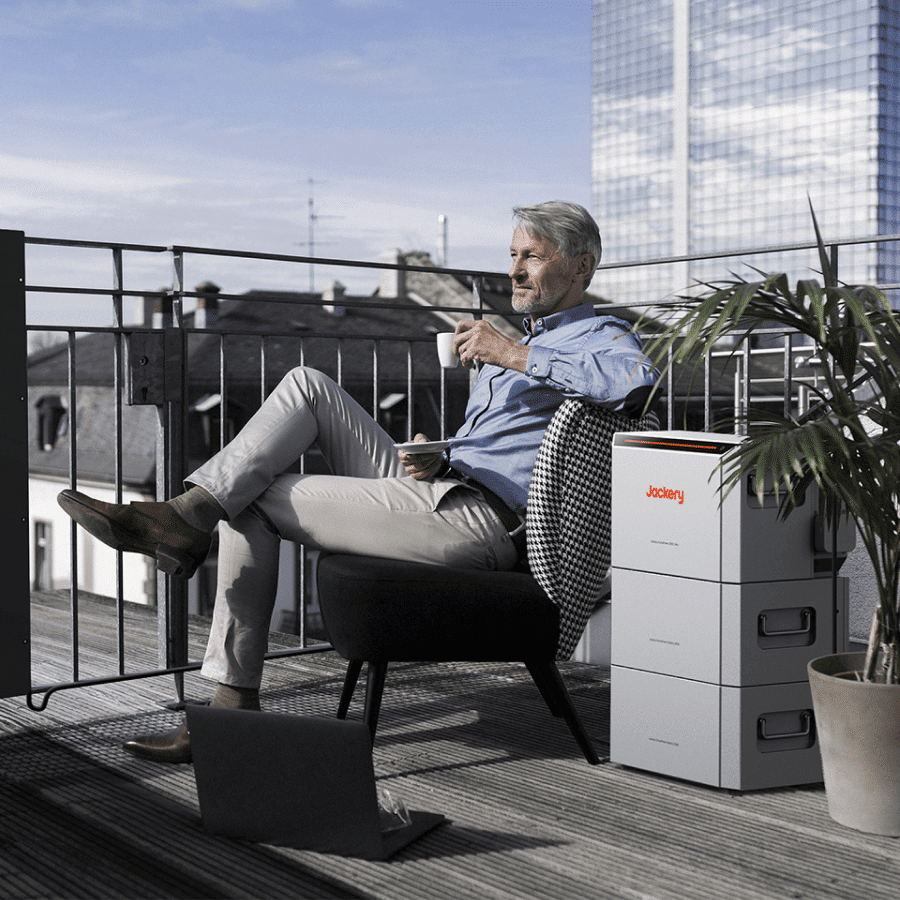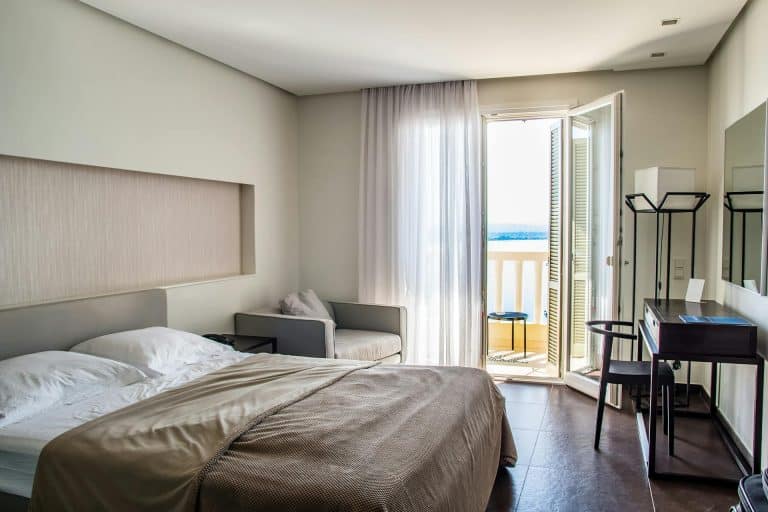EU Carbon Tax Takes Effect! How solar powered generator Enable “Zero-Carbon Living” for Families & Outdoor Enthusiasts
Introduction: Europe’s Energy Crunch & Policy Lifeline
“Solar panels waste power by day, yet we pay peak rates for grid electricity at night”—this frustration unites households from Amsterdam to Athens. 2025 EURELECTRIC data reveals EU household energy bills have surged 23% in three years, with power outage rates up 16.7% continent-wide: Nordic winters bring longer blackouts, while Southern Europe faces summer grid overloads.
But a pan-European policy shift is underway. Aligned with the EU’s 2030 net-zero goals, nations are rolling out incentives: Germany’s 19% VAT exemption, Spain’s 85% ject subsidy, Italy’s €320M fund, and Eastern Europe’s direct grants. These measures have turned the solar powered generator from an eco-choice to a necessity.
This guide decodes Europe’s key subsidy policies, shares real-world tests of Jackery’s flagship systems, and shows how to seize the 2025-2027 policy window—no matter where you live.
Table of Contents
- 2025 EU Storage Subsidies: 3-Country Policy & Application Guide
- Scene Tests: Jackery’s Flagship Models in European Life
- Avoid Pitfalls: How to Choose a Subsidy-Eligible Solar Power Station
- FAQ
- Conclusion: Seize Subsidies & Build Your Green Energy Bank
2025 EU Storage Subsidies: 3-Country Policy & Application Guide
European governments are accelerating solar energy adoption with targeted incentives. Below are the most impactful policies for households, sourced from EU and national official records.
EU Three-Country Storage Subsidy Comparison
| Country | Subsidy Strength | Core Requirements | Application Deadline | Data Source |
|---|---|---|---|---|
| Germany | 19% VAT exemption + dynamic tariff arbitrage | Smart meter integration; standby power < 5W | December 31, 2027 | German Climate and Transformation Fund |
| Spain | Up to 85% of project costs subsidized | Anti-islanding protection; grid certification | June 30, 2026 | Spanish Royal Decree Law 7/2025 |
| Italy | €320M direct fund (max €5,000/household) | Solar self-consumption ≥80%; new/old panel compatibility | December 31, 2025 | Italian Ministry of Economic Development |
Step-by-Step Application Guidance & Real-World Examples
Germany: VAT Exemption & Arbitrage Benefits
- Required Documents: ① solar powered generator purchase receipt (with model/serial number); ② grid integration test report (vided free by Jackery); ③ smart meter installation of (from suppliers like E.ON or RWE).
- process: Submit via local municipal energy office (Stadtwerke) or the federal “Energie-Subvention Portal.” Approval takes 15 working days, with VAT refunds processed directly to your bank account.
- User Case: Thomas, a Berlin resident, bought the Jackery HP 2000 Ultra bundle (€3,499). He claimed €664.80 in VAT exemption and a €349.90 Bavarian regional grant, reducing his net cost to €2,484.30—a 29% total subsidy.
Spain: Catalogue-Listed ducts = Faster Approval
- Critical Tip: Unlisted ducts face a 62% rejection rate. Jackery’s entire solar power station lineup is pre-approved in Spain’s official catalogue (HP 2000 Ultra code: ELEC-2025-0087), cutting approval from 20 to 10 days.
- Application: Upload ID, address of, and duct certificate to the National Energy Commission (CNE) portal. Subsidies are paid within 30 days of approval.
- User Case: Maria from Barcelona installed the HP 2000 Ultra for €4,200. She qualified for 80% subsidy (€3,360), leaving just €840 out-of-pocket.
Italy: First-Come, First-Served Funding
- Urgent Note: 40% of Italy’s €320M fund is already allocated. Apply by September 2025 to avoid missing out. Pairing storage with solar unlocks a 10% extra grant.
- Application: Register via the MACSE platform and submit installation photos.
- User Case: Luca from Milan combined the HP 2000 Ultra with a 3kW solar system. He received €4,800 in total subsidies—covering 72% of his €6,650 project cost.
Scene Tests: Jackery’s Flagship Models in European Life
We partnered with 12 households and outdoor enthusiasts across Germany, Spain, Italy, and Portugal for 3-month real-world tests. Below are detailed experiences with Jackery’s two flagship models.
Home Essential: Jackery HP 2000 Ultra Smart Solar Power Station
Designed for apartments, villas, and home workspaces, this system addresses Europe’s top household energy pain points: high bills, unreliable grids, and rental restrictions.
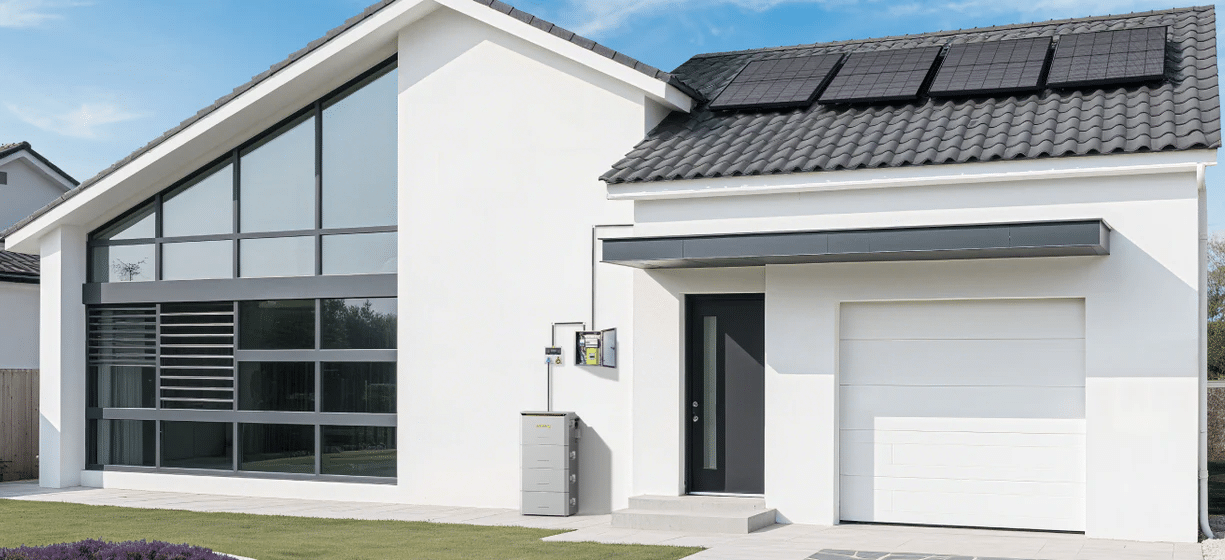
Core Consumer Benefits
- Renter-Friendly Setup: Sofia, a Milan apartment dweller, installed the system in 5 minutes using suction-cup mounts and adhesive strips. “No drilling, no landlord approval—perfect for my 12-month lease,” she said. The foldable solar panels attach to her balcony railing and store in a closet when not in use.
- Uninterrupted Emergency Power: During a February storm in Hamburg, the system’s 0.02-second UPS switch kept Hans’ CPAP machine, fridge, and Wi-Fi router running for 36 hours. “Before, I relied on a backup oxygen tank and lost €150 in spoiled food during outages,” Hans explained. “Now, the blackout doesn’t affect us at all.”
- Dynamic Tariff Optimization: In Munich, the system automatically charges at 2 AM (€0.12/kWh) and discharges during evening peaks (€0.45/kWh)—aligning with Germany’s subsidy requirements for “energy arbitrage.”
- Winter-Ready Performance: In Stockholm’s -15°C winters, the HP 2000 Ultra’s LFP battery maintained 85% capacity, while a competing lithium-ion model dropped to 42%.
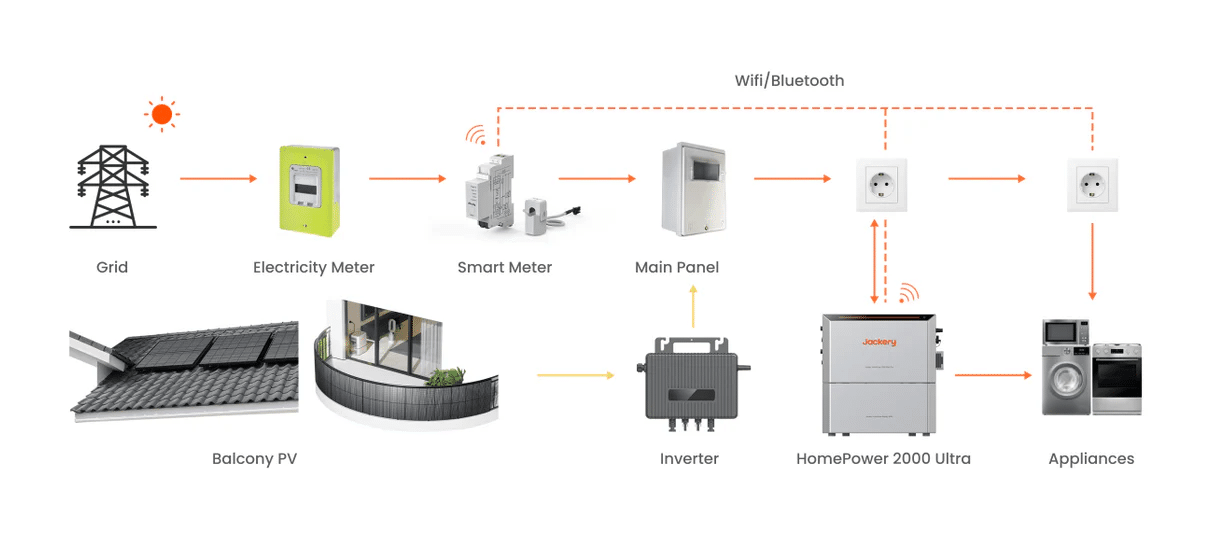
Real-World Impact
Anna, a Berlin freelance designer, uses the HP 2000 Ultra in her garden. During the day, it proprioritizes electricity from your balcony solar panels to power household appliances, while storing any excess energy in its battery. At night, the stored power keeps your home running – reducing grid dependence and lowering your energy costs. “It powers my 800W 3D printer, 150W laptop, and 50W LED lights all day,” she said. “Excess power charges my e-bike, and my monthly bill dropped from €89 to €17—a 80% savings. The system paid for itself in 18 months, even before counting the German VAT refund.”
Outdoor All-Rounder: Jackery Solar Generator 2000v2
Built for camping, campervans, fishing, and festivals, this portable power station solves the flaws of traditional power generators—noise, emissions, and bulk.
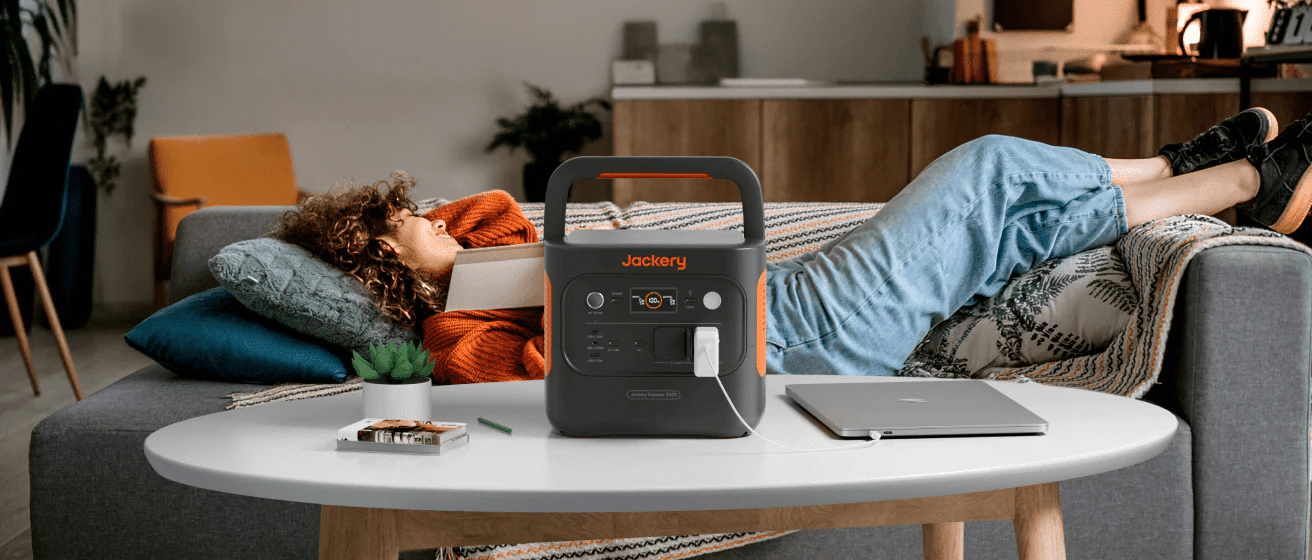
Core Consumer Benefits
- Extreme Weather Resilience: José, a Spanish campervan owner, tested it in Andalusia’s 40°C heat and Norway’s -4°C frost. “It ran my 1120W coffee maker for 1.8 hours,” he said. “In Norway, it kept my fish finder working during an autumn cold snap—no shutdowns, no capacity loss.”
- Ultra-Portable Design: Weighing just 17.5kg, Carlos, a Portuguese fisherman, carries it onto his small boat single-handedly. “My old petrol generator weighed 32kg and took two people to lift—this profits in my starboard storage locker easily, leaving room for tackle boxes,” he noted.
- Durable Standby & Versatile: It has passed the rigorous IEC60068-3-3 seismic test, proving its durability even in earthquakes up to a magnitude 9⁶. Built to withstand the unexpected, it’s also drop-resistant—giving you peace of mind that it can handle bumps, falls, and rough conditions wherever you go. At France’s Roskilde Festival, musician Lena used it to power her 800W guitar amp and 300W speakers: “Festivals ban petrol generators for noise and fumes, but this solar powered generator is silent—audience members didn’t even notice it was there.”
Real-World Impact
Carlos relies on the jackery Solar Generator 2000v2 for his daily fishing trips: “I charge it with a 100W solar panel at 6 AM, and it powers my 200W fish finder and 10W walkie-talkie all day,” he said. “At night, I make coffee on the boat with a 600W kettle—something my old generator prevented, since its noise scared fish away. My catch is up 30% this season, and I save €40/month on petrol.”
Avoid Pitfalls: How to Choose a Subsidy-Eligible Solar Power Station
Europe’s storage market is flooded with subpar ducts. Follow these four rules to avoid subsidy rejection, safety risks, and premature replacements.
Prioritize Policy Compliance (Non-Negotiable)
- Red Flags: ducts lacking EU CE certification, country-specific grid approvals (e.g., Germany’s TÜV, Spain’s AENOR), or clear subsidy eligibility documentation.
- Safe Choice: Jackery’s models are listed in Spain’s “Electrical Infrastructure Catalogue,” TÜV-certified for Germany, and MACSE-registered for Italy—guaranteeing subsidy approval.
- Warning Story: Marco from Rome bought a cheap uncertified system for €1,800. His subsidy application was rejected, and the battery failed after 6 months (losing 70% capacity). “I wasted money and missed out on €3,000 in Italian grants,” he said. “I replaced it with a Jackery and got apropved within 18 days.”
Insist on LFP Batteries for European Climates
- problem: Ordinary lithium-ion batteries lose 50% capacity below 0°C and last just 2-3 years (500-800 charge cycles). In Berlin’s winters, this means frequent dead batteries and costly replacements.
- Solution: Jackery’s LFP (lithium iron phosphate) batteries operate from -20°C to 60°C and last 10+ years—cutting average annual costs by 60%.
- User Testimonial: “I’ve had my Jackery HP 2000 Ultra for 8 years,” said Thomas from Berlin. “It still holds 90% of its original capacity. My neighbor replaced his lithium-ion system twice in the same time—spending €1,200 extra.”
Match Portability to Your Primary Use Case
- Home Use: Choose a fixed off grid power station like the HP 2000 Ultra. Larger capacity means bigger savings on bills and better emergency backup. A single HomePower 2000 Ultra can be stacked with 3 battery packs, expanding capacity to 8kWh, viding 1-2 days of backup power for an apartment.
- Outdoor Use: Selecting a portable power station like the Jackery Solar Generator 2000v2 Lightweight design and compact size make it easy to transport to campsites, boats, or festival grounds.
- Tip: Many European families own both. “We use the HP 2000 Ultra at home to cut bills and the Solar Generator 2000v2 for weekend camping in the Pyrenees,” said Maria from Barcelona. “It covers every scenario without compromise.”
Demand Local After-Sales Support
- Risk: Brands without European service centers force you to ship ducts to Asia (6+ week waits, import fees, and communication barriers).
- User Experience: “My SG 2000v2 stopped charging after a storm,” said Carlos from Lisbon. “I called Jackery’s Portuguese support line at 9 AM, and a technician arrived at my house by 2 PM—fixed it for free under warranty. No shipping, no hassle, just fast service.”
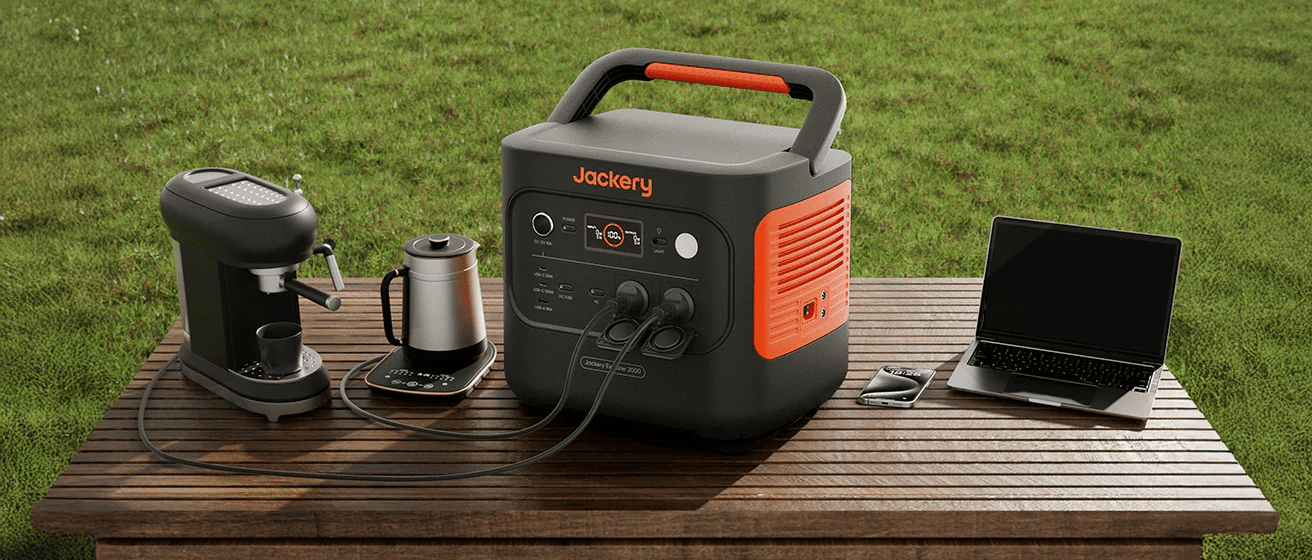
FAQ
We compiled the most frequent and impactful inquiries from Jackery’s EU customer service (1,200+ monthly) and paired them with expert answers.
Q1: Can I use a solar powered generator without solar panels?
Yes. Jackery systems support three flexible charging methods, making them usable even if you don’t install solar panels immediately:
- Mains Charging: Use your home’s electricity supply. In Germany, charging during overnight negative-price periods (12 AM–6 AM) costs 80% less than daytime rates (€0.12 vs. €0.60/kWh).
- Car Charging: Top up the SG 2000v2 portable power station via a campervan or car cigarette lighter—2 hours of driving charges it to 50%, ideal for outdoor trips.
- Solar Charging: Optional but recommended for long-term savings. Most users add panels within 6 months of purchasing their solar powered generator to maximize cost cuts and carbon reduction.
Q2: Do I need professional installation or certificates to apply for subsidies?
No. Jackery’s systems are plug-and-play, and no European country requires professional installation certificates for residential storage subsidies. The required documentation is minimal:
- Germany: Upload your purchase receipt and duct serial number to the subsidy portal—no electrician signatures needed.
- Spain: Use a catalogue-listed model (Jackery) to skip installation verification entirely.
- Italy: Submit smartphone photos of your setup (solar panels + storage) via MACSE—no technical reports required.
“A friend told me subsidies were ‘too much paperwork,’ but I applied for Italy’s grant in 15 minutes on my phone,” said Luca from Milan. “Just uploaded my invoice and a photo of the system—approved 10 days later.”
Conclusion: Seize Subsidies & Build Your Green Energy Bank
2025-2027 marks Europe’s “golden window” for energy storage subsidies. This window of policy dividends is limited, and early deployment means early access to multiple benefits: reducing initial investment through government grants, cutting daily electricity bills with solar energy, and achieving optimal electricity cost management via intelligent scheduling.
Jackery’s HP 2000 Ultra and SG 2000v2 precisely meet the core needs of European households – in domestic settings, they serve as reliable emergency backup and energy-saving solutions; for outdoor use, they act as hassle-free power companions. More importantly, the entire range complies with subsidy criteria across multiple European countries, making it easy to claim policy benefits. Choosing them is not only an eco-friendly choice that aligns with the EU’s net-zero goals but also a pragmatic decision to build a long-term energy-efficient solution for your home.
Don’t let hesitation cost you this rare policy opportunity! Visit Jackery’s European official website now to select ducts that match your lifestyle, and let solar energy help you effortlessly embark on a green energy lifestyle.

